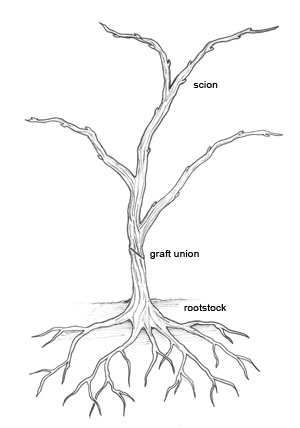Parts of the Grape Vine: Roots
 Fig. 1
Grafted vine, showing rootstock, scion, and graft union.
Grapevines
can be grown on their own root systems (own-rooted or self-rooted
vines) or they may be grafted onto a rootstock. A grafted vine consists
of two parts, the scion variety (e.g., Pinot noir), which produces the
above-ground parts (trunk, shoots, and fruit), and the rootstock
variety (many of which are often numbers, e.g., 101-14), which provides
the root system and lower part of the trunk. The position on the trunk
where the scion and rootstock are joined by grafting grows together and
is called the graft union. Successful healing of the graft union
requires that the vascular cambium of both the rootstock and scion are
in contact with each other, since these are the only tissues having
meristematic activity necessary for the production of new cells to
complete the graft union. Healing of the graft union often results in
the production of abundant callus tissue (a wound healing tissue
composed of large thin-walled cells that develop in response to
injury), often making the area somewhat larger than adjacent parts of
the trunk. Because rootstock and scion varieties may grow at different
rates, trunk diameter can vary above and below the graft union.
Why use rootstocks?
Rootstock varieties were originally developed to provide a root system for Vitis vinifera
L. (“European” winegrape) varieties that are resistant or tolerant to
phylloxera, an insect native to North America and to which V. vinifera
roots have no natural resistance. Subsequently, rootstocks have been
developed based on other desirable characteristics including resistance
or tolerance to various nematodes (microscopic soil-borne roundworm)
and adaptation to different soil conditions. Rootstock variety may also
influence nutrient uptake, vigor of the scion variety (the
fruit-producing portion of a grafted vine) and to some extent its
phenology.
Most rootstocks are either native North American species or hybrids of two or more of these species, including Vitis riparia, Vitis berlandieri, and Vitis rupestris.
The rooting pattern and depth, as well as other root system
characteristics, vary among the species and hybrid rootstocks,
therefore the rootstock can influence aspects of vine growth, including
vigor, drought tolerance, nutrient uptake efficiency, and pest
resistance. Therefore, rootstock variety selection can be an important
factor in vineyard development.
The function of grapevine roots
° Provide a physical anchor of the vine
° Absorb water and mineral nutrients
° Store carbohydrates and nutrients in reserve for future use
° Produce hormones that control plant functions
The
root system of a mature grapevine consists of a woody framework of
older roots (Richards, 1983) from which permanent roots arise and grow
either horizontally or vertically. These roots are typically
multi-branching, producing lateral roots that can further branch into
smaller lateral roots. Lateral roots produce many short, fine roots,
which has the effect of increasing the area of soil exploited
(Richards, 1983). Certain soil fungi, called mycorrhizae, live in a
natural, mutually beneficial association with grape roots. Mycorrhizae
influence grapevine nutrition and growth, and have been shown to
increase the uptake of phosphorus.
The majority of the grapevine
root system is found within the top 3 feet (Richards, 1983; Winkler, et
al., 1974) of the soil, although individual roots can grow much deeper
in certain soil conditions and profiles. Distribution of roots is
influenced by soil characteristics: the presence of hardpans or other
impermeable layers, the rootstock variety, and cultural practices such
as the type of irrigation system (Mullins et al., 1992). Grapevine
roots require good internal soil drainage to function. Water-saturated
soils do not have air spaces that allow roots to respire. High water
tables and heavy textured soils (fine silty loams and clays) often
restrict root growth, and thereby limit vine size and nutrient uptake
from soils. Subsurface drainage tiles are often recommended in
non-irrigated production areas to improve internal soil drainage.
Reviewed by Tim Martinson, Cornell University and Patty Skinkis, Oregon State University
References:
Mullins, M. G., A. Bouquet, and L. E. Williams. 1992. Biology of the Grapevine. Cambridge University Press.
Richards, D. 1983. The Grape Root System. Horticultural Reviews 5:127-168.
Winkler,
A.J., J.A. Cook, W.M. Kliewer, and L.L. Lider. 1974. General
Viticulture. University of California Press. Berkeley, California.
Further Reading
Parts of the Grape Vine: Flowers and Fruit, eXtension Foundation
Parts of the Grape Vine: Shoots, eXtension Foundation
Grapevine Fruit Phenology, Aggie Horticulture® Texas A&M
AgriLife Extension pdf
Grapevine Shoot Phenology, Aggie Horticulture® Texas A&M
AgriLife Extension pdf
Grapevine Structure and Function, Oregon Viticulture pdf
Back to
Muscadine Grape Page
Bunch Grape Page
|
